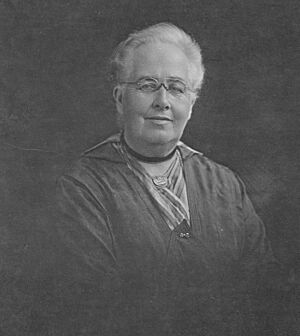Elizabeth Webb Nicholls facts for kids
Elizabeth Webb Nicholls (born February 21, 1850 – died August 3, 1943) was a very important leader in the fight for women's right to vote in South Australia. This movement was called 'suffrage'. She worked hard in the 1890s to make this happen.
Elizabeth held important positions in Adelaide, the capital of South Australia. She was the President of the Woman's Christian Temperance Union (WCTU) of South Australia. This group was one of the most active in helping women get the right to vote. Thanks to their efforts, South Australia became the first Australian colony to allow women to vote in 1894.
Contents
Early Life and Family
Elizabeth Nicholls was born on February 21, 1850, in Rundle Street, Adelaide. Her parents were Samuel Bakewell, a grocer, and Mary Ann. When Elizabeth was only three years old, her mother passed away. She then lived with relatives in England for a few years before coming back to Adelaide.
Her father, Samuel, later married Mary Ann's sister, Eliza Hannah. On August 2, 1870, Elizabeth married Alfred Richard Nicholls, who worked in a warehouse. They had one daughter and four sons. They also welcomed two orphaned relatives into their home and raised them as their own children.
When she was young, Elizabeth once said, "I long to have the will and the power to be very useful." This shows her desire to make a difference.
Political Connections and Community Work
Elizabeth's father, Samuel, and her uncle, William, both became members of the South Australian House of Assembly. This gave her some early understanding of local politics.
She was also an active member of the Archer Street Wesleyan church in North Adelaide. There, she taught Sunday School and shared religious writings with others.
People described Elizabeth Nicholls as being "short in stature, with a benign expression." She was a pleasant speaker who didn't seem to worry about herself. Her efficiency and passion quickly earned her the respect of others. It was also said that she would quietly get annoyed by "unreasonable restraint."
Joining the Woman's Christian Temperance Union
In July 1886, Elizabeth Nicholls joined the Woman's Christian Temperance Union of South Australia (WCTU). This was just three months after the group was formed. She became very involved in 1888.
Later that year, she became the temporary president of the Adelaide branch. In 1889, she was elected the colonial president, a position she held until 1897. In 1891, Elizabeth was one of the first women allowed to join the South Australian Temperance Alliance.
Elizabeth Nicholls also started the WCTU's own newspaper, Our Federation. She was its editor from 1898 until it stopped being published in 1904.
Leading the Fight for Women's Vote
Elizabeth Nicholls brought new energy to the WCTU's work for women's suffrage. She encouraged women to write letters to their local Members of Parliament. She spent a lot of time teaching women about their potential in politics. She gave many speeches in different places, explaining the basics of how to register and how to vote. She used her 'Platform of Principles' to guide her talks.
Elizabeth also joined the Women's Suffrage League of South Australia and became a League Councillor. In 1894, she took on the role of Colonial Superintendent for the WCTU's Suffrage Department.
Elizabeth Nicholls played a big part in collecting signatures for the 1894 suffrage petition. Out of 11,600 signatures, she helped gather 8,268 of them. This petition was sent to the Parliament of South Australia. It led to the passing of the Constitutional Amendment (Adult Suffrage) Act 1894, which gave women the right to vote.
Later Years and Continued Advocacy
From 1895 to 1922, Elizabeth Nicholls was an appointed member of the Adelaide Hospital Board. In 1915, she was one of the first four women to be appointed as a Justice of the Peace. She often served in the Children's Court. Elizabeth also pushed for other Australian states to appoint women to similar roles. She argued for changes in prisons to make them better. She also worked to improve conditions and wages for women who were working. This led her to become a shareholder in the women's South Australian Co-operative Clothing Co.
From 1909, Elizabeth was a member of the Women's Non-Party Political Association, becoming its president in 1911. She remained very passionate about women's right to vote. She was elected vice-president of the League of Women Voters. In 1920, she attended the 10th World Convention of the International Alliance of Women in Geneva. In 1921, she helped start the Australian Federation of Women Voters. She also spoke to the League of Nations (which is now the United Nations) on behalf of Australian women.
Elizabeth Nicholls stayed dedicated to the WCTU throughout her life. She was involved in a successful vote that resulted in hotels closing at 6 pm in 1915. She believed all these changes would lead to a better society.
Her husband, who had worked for 55 years with G. & R. Wills & Co., passed away on November 11, 1920. Elizabeth Nicholls then moved into Willard House, which was the WCTU's headquarters and residence in Adelaide. It was on Wakefield Street near Francis Xavier's Cathedral. She died in North Adelaide on August 3, 1943. She is buried in Payneham cemetery, South Australia.
See also
 In Spanish: Elizabeth Webb Nicholls para niños
In Spanish: Elizabeth Webb Nicholls para niños



